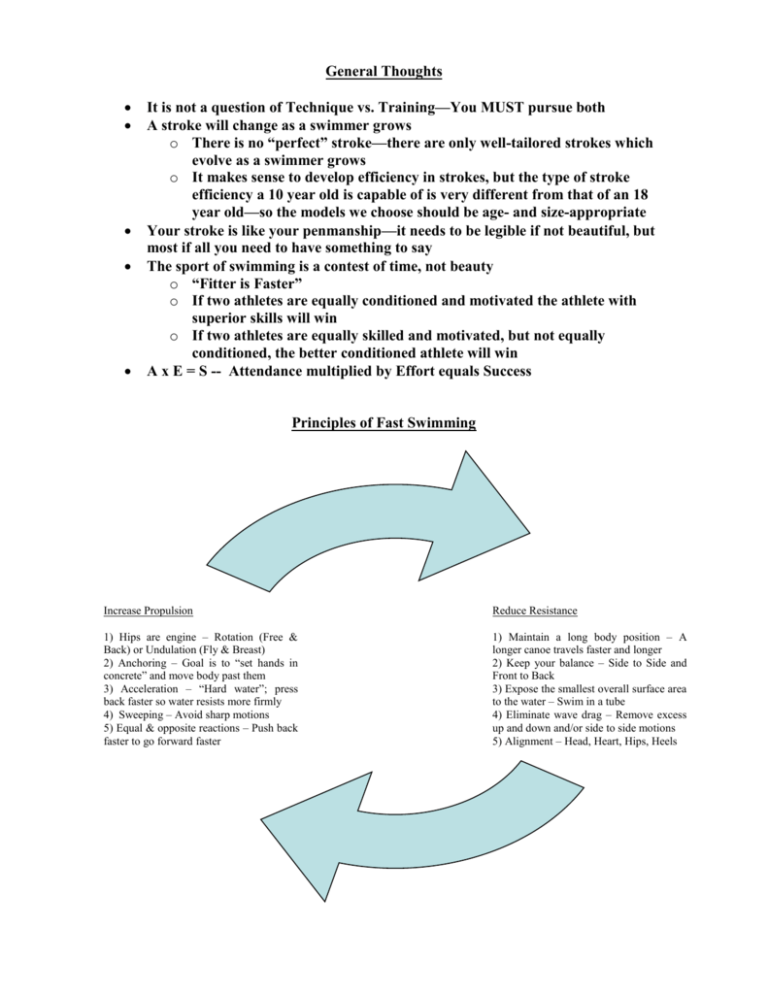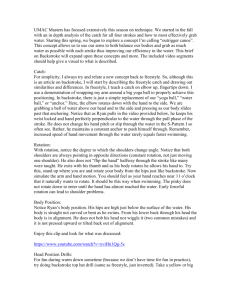Principles of Fast Swimming
advertisement

General Thoughts It is not a question of Technique vs. Training—You MUST pursue both A stroke will change as a swimmer grows o There is no “perfect” stroke—there are only well-tailored strokes which evolve as a swimmer grows o It makes sense to develop efficiency in strokes, but the type of stroke efficiency a 10 year old is capable of is very different from that of an 18 year old—so the models we choose should be age- and size-appropriate Your stroke is like your penmanship—it needs to be legible if not beautiful, but most if all you need to have something to say The sport of swimming is a contest of time, not beauty o “Fitter is Faster” o If two athletes are equally conditioned and motivated the athlete with superior skills will win o If two athletes are equally skilled and motivated, but not equally conditioned, the better conditioned athlete will win A x E = S -- Attendance multiplied by Effort equals Success Principles of Fast Swimming Increase Propulsion Reduce Resistance 1) Hips are engine – Rotation (Free & Back) or Undulation (Fly & Breast) 2) Anchoring – Goal is to “set hands in concrete” and move body past them 3) Acceleration – “Hard water”; press back faster so water resists more firmly 4) Sweeping – Avoid sharp motions 5) Equal & opposite reactions – Push back faster to go forward faster 1) Maintain a long body position – A longer canoe travels faster and longer 2) Keep your balance – Side to Side and Front to Back 3) Expose the smallest overall surface area to the water – Swim in a tube 4) Eliminate wave drag – Remove excess up and down and/or side to side motions 5) Alignment – Head, Heart, Hips, Heels Long Axis Strokes – Rotation of the body occurs along an imaginary line from head to toe Freestyle—Body Posture – Proper land posture is also proper water posture. Rotation – The hips rotate enough to “load” the core muscle of the abdomen then shift back the other way as the anchored hand is leveraged with all the muscles in the torso; the breath occurs at the of the rotation; repeat on the other side. Freestyle—Legs Kick – The legs are the foundation of the modern freestyle stroke. Constant kicking with straight legs (not rigid) and floppy feet is required; nothing except the flipturn should stop the feet from kicking from the start to the finish of the race. Freestyle—Arms Entry – Fingertips of Thumb, Index, and Middle fingers enter the water first, which leads to a high elbow position as the entire hand enters the water. Catch – As the hand reaches maximum extension the shoulder rolls forward creating the “Early Vertical Forearm” position characteristic of modern freestyle. Press – The hand and forearm press backwards towards the feet as a unit (almost as if the wrist did not exist); the press should accelerate straight back with the fingertips continuously pointing towards the bottom of the pool. Finish – As the hand finishes press it exits that water beside the hip bone. Recovery – The arms should bend and remain as relaxed as possible; the next pull does not begin until the elbow of the recovering arm is over the swimmers ear. Freestyle—Breathing Breathe with the hip – The breath occurs near the end of the pull as part of the hip turning. If it is done properly one goggle should stay immersed and the head should create a trough around the mouth in which the breath takes place. ________________________________________________________________ Backstroke—Body Posture – The body should be aligned in a very slight downward curve so that is present a hulllike frontal surface to the water. Rotation – The hips rotate enough to “load” the core muscle of the abdomen then shift back the other way as the anchored hand is leveraged with all the muscles in the torso; the breath occurs at the of the rotation; repeat on the other side. This is essentially the same motion as freestyle. Backstroke—Legs Kick – The feet should boil the surface of the water. The kick should be done with relatively straight legs (not rigid) so that the strong muscles of the upper leg and hips are engaged; nothing except the flipturn should stop the feet from kicking from the start to the finish of the race. Backstroke—Arms Entry – Karate chop hands into water; maintain mechanical advantage gained by straight arm recovery. Catch – Let the hand (with a straight wrist!) sink well below the surface by rotating hips and then rotate shoulder forward (adduction) into high elbow (very similar to freestyle). Press – Sweep hand backwards; let it travel in an “S” pattern towards the feet which is drawn by the large general rotation of the hips, not the small specific motion of the hands; this will ensure the power is coming from the hips, not from the arms only. Finish – At the end of the underwater press the thumb comes out of the water first. Recovery – The arm comes straight over the body (not around sideways), stays straight as the shoulder lifts, and enters the while still straight (not bending as it enters the water). Backstroke—Breathing The breath occurs naturally, sometimes in rhythm with the arms (in on one stroke and out on another) and sometimes haphazardly, but should always be a full inhalation and exhalation. Short Axis Strokes – Rotation of the body occurs across an imaginary line from hip to hip Butterfly—Body Posture – The body moves from a neutral, level floating position to a chest-forward, convex propulsive position, back to a neutral position, to a concave recovery/breathing position and then starts the cycle over again. Rotation – The body should “teeter-totter” back and forth in the water, constantly aiming to shift weight forward and down by pressing on the lungs and “swimming downhill.” Butterfly—Legs Kick – The feet are turned inward slightly so that toes closer together than the knees during the downward kick. Two kick occur during each stroke cycle: first when the hands make the catch, and second when the hands come together under the body near the navel. Butterfly—Arms Entry – Hands enter the water with the thumbs and index finger first, setting up the high elbow position Catch – As the hands sink under the surface at shoulder width, the shoulders rotate forward into a strong high elbow position Press – Push backwards as if pushing against the deck to get up out of the pool and let the hands sweep in so they almost meet at the belly button Finish – Press hands back and around the hips with pinkies leaving the water first Recovery – Swing the hands around wide, close to the surface; arms should not be lifted over the water from the elbows, but flung around as if reacting to the push underwater Butterfly—Breathing The breath occurs when the hands are coming together under the body and the second kick occurs. The chin should be pushed forward, not up, so that the face seems to be surfing on the water. No part of the throat or chest should be visible out of the water. ________________________________________________________________ Breaststroke—Body Posture – The body moves from a neutral, level floating position to a chest-forward, convex propulsive position, back to a neutral position, to a concave recovery/breathing position and then starts the cycle over again. Rotation – The body should “teeter-totter” back and forth in the water, constantly aiming to shift weight forward by lowering the head and pressing on the lungs. Breaststroke—Legs Kick – As the knees bend from the straight, steamlined position the feet should move toward the buttocks (rather than the knees moving towards the chest); the lower part of the leg should hide behind or “stay in the shadow” of the upper part of the leg to reduce resistance. The knees are held shoulder width apart. As the legs drive backwards to initiate the kick, the feet flare out and catch the water. The feet whip around and back until the legs are completely straightened and nearly touching. Breaststroke—Arms Entry – Hands extend fully in front of body in a streamlined position Catch – Hands move sideways into a wide “Y” position with pinky fingers leading the way, then anchor themselves in the water Press – Elbows bend so that the forearm is in a vertical position (perpendicular to the surface of the water) and hands sweep towards each other with the thumb leading the way (as if the palms were running along the inside of two large bowls) Finish – Hands nearly touch each other under the chin and then, without hesitation, move forward naturally as the breath occurs Recovery – Hands quickly extend into a streamline Breaststroke—Breathing The breath occurs when the hands are coming together under the chest during the in-sweep portion of the pull, not during any portion of the out-sweep (which characterized by a continuous head down position).





